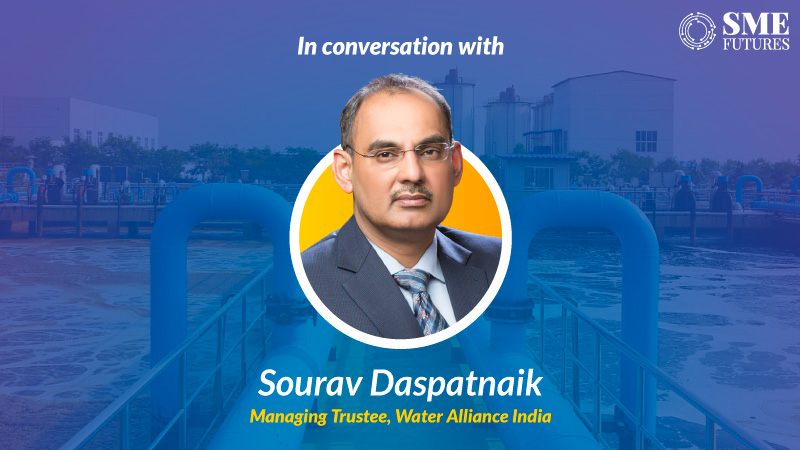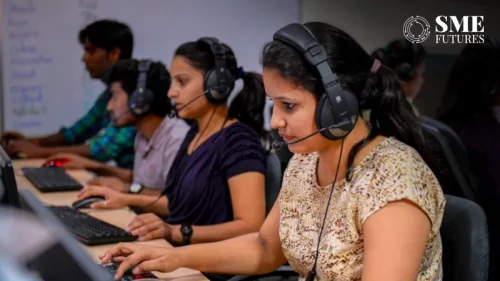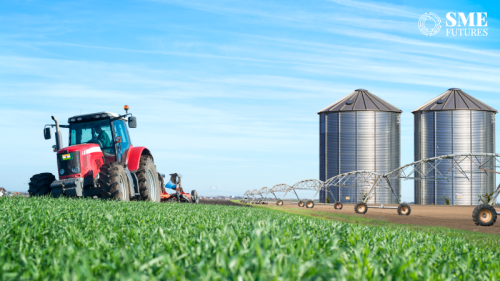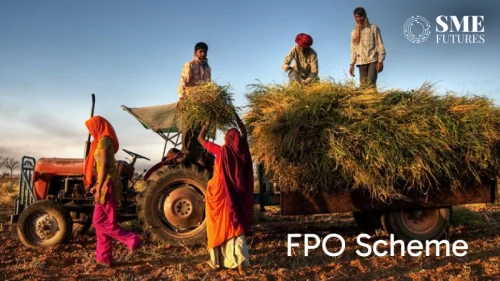Lately, the Indian water infrastructure players have been feeling neglected by the government. Reason being that the water and wastewater sector is not included in the Emergency Credit Guarantee Limit Scheme (ECLGS 2.0).
This scheme was a response to the crisis caused by the COVID-19 pandemic. Under this scheme, the government guarantees additional facilities provided by the lending institutions to their existing borrowers. And loans under ECLGS can be sanctioned only until 30th September 2021 and can be disbursed until 31st December 2021.
Moving on, the scheme was revised as the ECLGS 2.0, where 27 sectors, including 26 sectors defined by the committee, could avail of the scheme. Later, the hospitality, travel and tourism, leisure and sports sectors were also included in the list of eligible sectors. However, the water infrastructure sector has been kept out of the scheme due to the non-listing of the water sector in the 26 areas as defined by the KV Kamath Committee.
With time still on their hands, the sectoral apex bodies and companies such as Water Alliance India, Ion Exchange Ltd., Swachh Environment Pvt Ltd, Nangloi Water Services Pvt Ltd and others are urging the government to expand the eligibility list of the sectors that can avail of the ECLGS.
“It is a matter of great concern that the water, wastewater and sanitation sectors which have been at the forefront of the COVID-19 crisis are not included in the eligible sectors,” comments Sourav Daspatnaik, Managing Trustee, Water Alliance India. “Electricity, water, wastewater management and sanitation should be treated as an essential service. It cannot be subject to other fields. If such reliefs are not provided to the water, wastewater, and sanitation sectors as per the policies of the government, then the lifeline of the development of the water infrastructure in India will be crippled,” he adds.
Daspatnaik spoke to SME Futures on this subject and discussed the various facets of the water infrastructure industry and explained why the sector needs the ECLGS 2.0.
Edited Excerpts:
Please elaborate on the current state of India’s water infrastructure sector.
The water sector in India, currently, is under severe financial stress due to the COVID-19 pandemic with various drinking water and sanitation projects suffering immensely on account of the restrictions imposed on activities, the lack of manpower, the credit crunch and the shortage of raw material.
That said, the water infrastructure space has tremendous opportunities in the offing as well and is poised to grow at over 15 per cent YoY especially with the government’s push to ensure clean drinking water for all. Also, the pandemic has made it amply clear that water sanitation and hygiene are central to human health and wellbeing. The climate change and ESG (Environmental, Social and Governance) issues are bound to put water at the centre stage. The ambitious programme of the Jal Jeevan mission has given new momentum to water infrastructure development.
Do you agree that wastewater is vastly underutilised in India? What are the consequences of not reusing water properly?
India produces close to two million tonnes of faecal waste every day and the urban areas alone, accounting for just over a third of the total population of the country, generate over 62,000 million litres of sewage daily. Of this, close to 38,000 million litres is dumped untreated, most of it in rivers, lakes and other water bodies. Eventually, contaminated water also enters the groundwater. Because of this, proper waste management cannot occur, upsetting the irrigation system. The crops are not able to grow because of the infectious bacteria and disease in the water. Because of this poor infrastructure and the absence of sewage control, 38 million Indians suffer from waterborne diseases like typhoid, cholera and hepatitis every year.
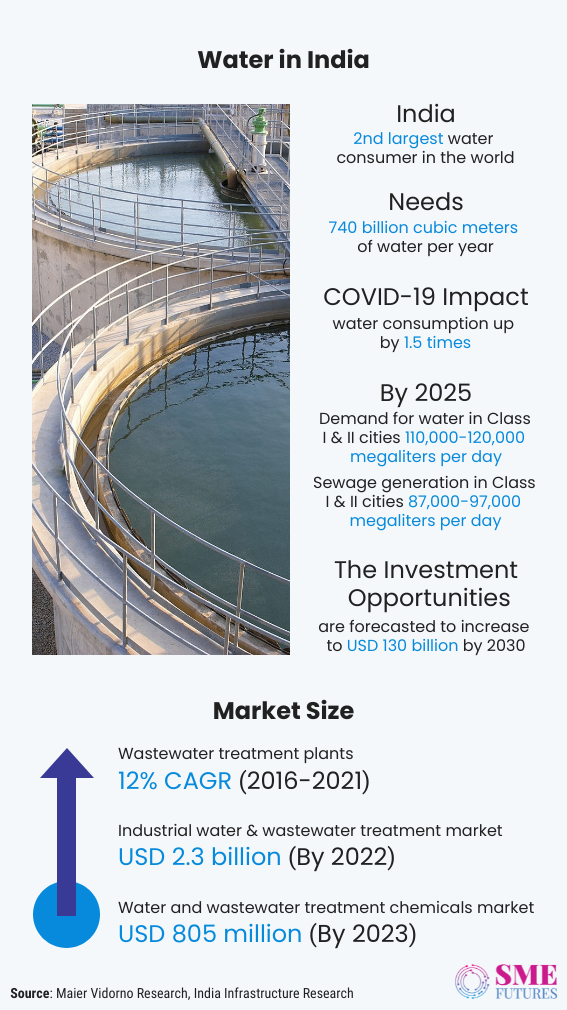
How has the pandemic affected this industry?
The disruptions in the on-going projects of water infrastructure especially at the construction sites have been there. A large number of water projects especially the water pipeline projects, and construction activities have also been affected.
These projects have suffered due to a combination of factors like the disruption in the supplies of raw materials and equipment, the lack of manpower, the lockdown related restrictions, higher procurement costs, higher wages, delays in payments and disbursements and so on. These have led to substantial financial stress for the companies and MSMEs executing the various projects under the Jal Jeevan mission, the drinking water projects in the states and the National Mission for Clean Ganga (NMCG) projects under implementation.
What is one challenge that the industry is facing at present; how is it hampering the growth of the sector?
The water and wastewater sector is a vital sector towards building a social infrastructure for the country. However, the government cannot build and carry out such a mammoth task alone. There is a need for the private sector to come forward and work together to build a strong and resilient water infrastructure in the country.
It would not be out of place to mention that many drinking water and wastewater management projects of the central and state governments have been severely impacted due to the COVID-19 pandemic and the consequential lockdowns. The viability of these projects is in the doldrums and the MSMEs will not be able to run at the pre-COVID levels for a really long time.
Please tell us in brief about what your main demands from the government are for a quick recovery.
Our main demand is that the scope of the Emergency Credit Guarantee Limit Scheme (ECGLS) 2.0 be expanded to include the drinking water and the wastewater management sector as they are essential services.
Alternatively, the ECGLS 2.0 should be clarified to include the drinking water and the wastewater management sector in the ‘construction’ sector already identified by the KV Kamath Committee which means that water and wastewater and even sanitation must be given a separate identity as a sub sector under the infrastructure sector. They should be treated at par with utilities like power.
Can you elaborate on why the water and waste management sector needs to be included in the ECLGS?
The Government of India in response to the crisis caused by the COVID-19 pandemic, announced an Emergency Credit Line Guarantee Scheme (ECLGS). Under the scheme, the government undertook to guarantee additional facilities provided by the lending institutions to their existing borrowers. The same was further revised as the ECLGS 2.0 wherein the government guaranteed additional lending to the 27 sectors including the 26 sectors defined by the committee headed by Shri KV Kamath and the health sector. Later, the hospitality, travel & tourism, leisure and sporting sectors were included in the list of eligible sectors.
However, the water infrastructure players were not able to avail of this scheme in the absence of the water sector being listed in the 26 sectors defined by the KV Kamath Committee. The loans under the ECLGS can be sanctioned only up to 30.09.2021 and disbursed up to 31st of December 2021.
With no financial support in the face of cautious lending by financial institutions and a failure to define the water and wastewater projects under any of the pre-defined sub-sectors of infrastructure or construction in the ECLGS, this will spell doom for the viability of the projects which are battling with enormous financial challenges.
What would be the benefits to the MSMEs in the water sector if the ECLGS is made available for them?
The benefits to the MSMEs in the water sector would be immense.
The purpose is to help these business enterprises get relief from the COVID-19 pandemic related stress. To note a few – this would enable a collateral free, 100 per cent guarantee covered credit facility of up to 20 per cent of an outstanding loan as on 29th Feb 2020 for standard accounts up to Rs. 500 crores. The interest rate for loans from banks and FIs will be capped at 9.25 per cent; for NBFCs at 14 per cent. A 5-year tenure from the date of the first disbursement with a one-year moratorium on principal repayment will be offered.
There would be no additional processing fees or a guarantee fee levied by the MLIs. Besides, additional collateral would not have to be provided by the agencies availing of the ECLGS. These benefits will give a strong boost to the cash-flow position of the MSMEs under financial stress and can help revive their operations and other activities.
Why is it critical that the water and waste-water infrastructure projects receive immediate financial assistance under the ECGLS 2.0?
The scope of the ECLGS must be expanded to include the drinking water and wastewater management sector. This sector, like the other MSMEs, needs urgent relaxations and immediate support to survive.
In the absence of the ECLGS being extended to the water sector, many companies may be compelled to shut their operations which will not only cause great inconvenience to the public at large but will also result in producing a ripple effect on its workforce which will be left jobless during these testing times. Thus, the drinking water and wastewater management sector must be added to the list of sectors identified by the KV Kamath Committee, and the failure to do so will only add to the already mounting hardships for the MSMEs engaged in this sector
The ECGLS was introduced with the aim of helping the sectors which have been impacted due to COVID-19. However, it is believed that the drinking water and wastewater management sector has been completely overlooked as multiple projects have been crippled due to the lack of manpower, the lack of raw material, credit crunch, financial distress etc.
Besides that, what are the other measures that your sector needs?
If water is considered as an essential life supporting resource, it has to be given its due importance as it is a finite resource and is depleting rapidly.
Hence, the water sector needs clear guidelines. Apart from the inclusion of the water sector in the ECLGS 2.0 or the need for its realm to be expanded for its identification as a sub sector of the infrastructure sector, the water regulations for re-use must be mandatory. Urban local bodies must set up an enabling framework for the conservation and recycling of water. Seawater desalination should be encouraged for the water stressed areas along the coast.
Additionally, water should be considered for a priority sector lending status along with the tariff structure regulatory body enforcing water usage based on tariff. Water must be brought to the centre stage if the India of the future wants to be able to sustain the health and hygiene of its over 1.4 billion population.

